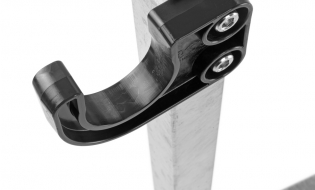Deutsche Bahn fully approves RSS safety barrier
This innovative new concept from RSS in the Netherlands uses magnets to attach
the safety barrier directly to the web of the rail.
Safety barriers
are used to protect rail track workers from moving trains on the parallel track. Safety
barriers are the safest way to protect the health and safety of railroad workers, but
due to a variety of circumstances traditional safety barriers cannot always be used.
Erection of traditional barriers is time consuming as they require removal of the
ballast from under the rail. Similarly on removal of the barrier, the ballast has to be
re-instated and tamped correctly. Unfortunately due to the above mentioned reasons
safety barriers are not always used, and we know that this can lead to incidents, even
fatal ones.
The TÜV tested RSS safety barrier with magnet has received approval
by the Deutsche Bahn and offers many additional benefits to the fundamental one of
protecting railway workers.
Tests done in the UK by Network Rail, (who incidentally
have also fully tested and approved the system for UK rail infrastructure PA05 05085)
with a gang of 5 operators showed that it is possible to erect 100 meters of RSS safety
barrier in 15 minutes, dismantling took 11 minutes – because there is no need to
remove or re-instate ballast. It took 2 hours with a gang of 10 people to erect and
dismantle 100 meters of conventional safety fencing, because of the need to remove and
re-instate the ballast.
Benefits
The distinct advantages
of the system are:
- Simple, safe and fast assembly/disassembly with a simple magnetic attachment to the web of the rail, with no requirement to remove or replace ballast
- No loose components
- No tools needed
- Very fast build time and thus a major saving in working and possession costs
- rss-rail-stanchion-a-021Very strong magnet (tensile force up to 600 kg)
- Easy dismantling with one arm movement
- The patented Magnetic Safety Barrier is easy to use and will therefore, be used
- Stanchions and tubes are transported in specially designed transport cradles that are stacked for efficiency
- Can be used even under freezing circumstances when ballast is frozen or covered with snow
- The easy way of erecting and dismantling will lead to better working conditions for your employees, thus reducing occupational health related problems
- Can be used in areas of ‘switches and crossings’ as being attached to the outside of the rail, it does not interfere with moving parts
- There is no danger to underground signaling cables as is the case with using stakes and ‘netlon fencing’
- The system does not affect track circuits or axle counters
- Utilizing GRP handrails it can be used in areas of OLE (Overhead Electric Lines)


